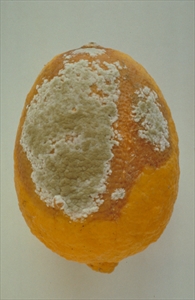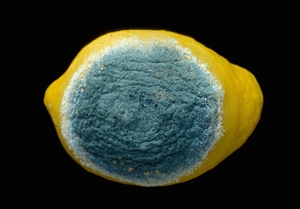Citrus blue and green moulds
Pacific Pests, Pathogens, Weeds & Pesticides - Online edition
Pacific Pests, Pathogens, Weeds & Pesticides
Citrus storage moulds (197)
Penicillium italicum (blue mould) and Penicillium digitatum (green mould).
Asia, Africa, North, South and Central America, the Caribbean, Europe, Oceania. Penicillium italicum is recorded on citrus from Australia, Cook Islands, Fiji, New Caledonia, Samoa, and Solomon Islands, and Penicillium digitatum from Australia, Cook Islands, Fiji, and Niue.
Citrus species primarily.
At first, small water-soaked areas - greyish, lacking a clear margin - on the fruits, enlarging rapidly to form white rots several centimetres in diameter. Spore masses develop giving the moulds their characteristic colours - green (Penicillium digitatum) and blue (Penicillium italicum) (Photos 1&2). The diseases caused by these moulds mostly occur in storage. In both cases, fruit rapidly spoils and collapses; at low humidity, the fruit may shrink and mummify.
The two Penicillium species are recognised by the size of their spores, the length of the stalks that hold the spores, and to a lesser extent the colour of the spores on their hosts.
Spores of these fungi are common in the atmosphere, spreading on the wind. The fungi infect through wounds in the fruit, but infection by contact can also occur (Photo 3). Handling creates the wounds required, as do fruit flies and other insects. In addition to injury and contact, infection is also helped by chilling in storage.
There is evidence that infection of fruit releases gases that increase spore germination of Penicillium species.
Penicillium fungi are a common cause of food spoilage, especially fruits and vegetables. Penicillium italicum and Penicillium digitatum are the most common fungi attacking citrus. Rots caused by Penicillium italicum are less common than those caused by Penicillium digitatum.
Both prefer cool temperatures, and are often found spoiling food kept in refrigerators. Of the two, Penicillium digitatum is considered the more important cause of postharvest decay; however, Penicillium italicum grows more quickly at temperatures below 10°C, and may be the more common of the two in cold storage.
Look for rots on citrus that are white at first, rapidly changing to either blue or green as spores develop. To be certain of the identification of the species, the spores and their stalks need to be examined microscopically by a fungal taxonomist.
CULTURAL CONTROL
Careful handling of the fruit, and proper disposal of those that are affected, are the main ways of reducing these diseases.
Before and after harvest:
- Do not pick fruit when wet as they are more likely to be wounded.
- Handle the fruit carefully when picking, in storage and during transportation.
- Remove infected fruit as soon as they are seen, including in and around packing sheds and on the ground in orchards. Dispose of the fruit before the fungi produce spores and spread the moulds.
- If fruit is to be held in storage for any length of time, make sure that it is refrigerated quickly to avoid the development of rots, which otherwise occur very quickly.
- Wrap fruit individually in paper to prevent fruit-to-fruit spread during storage and transport.
CHEMICAL CONTROL
Fungicides are used commonly as dips or sprays to prevent Penicillium rots. Thiabendazole is approved in Australia for post-harvest dips of citrus against these two Penicillium moulds. Fruits are dipped, without rinsing, in the product at the manufacturers' recommended dosage for 30 seconds, within 24 hours of harvest.
Hot-water treatment of fruit for the control of fruit flies also reduces infection by Penicillium moulds.
____________________
When using a pesticide, always wear protective clothing and follow the instructions on the product label, such as dosage, timing of application, and pre-harvest interval. Recommendations will vary with the crop and system of cultivation. Expert advice on the most appropriate pesticides to use should always be sought from local agricultural authorities.
AUTHOR Grahame Jackson
Information from CABI (2019) Penicillium italicum (blue mould), and Penicillium digitatum (green mould). Crop Protection Compendium. (https://www.cabi.org/cpc/datasheet/39581 and https://www.cabi.org/cpc/datasheet/39570); and from Penicilllium digitatum. Wikipedia. (https://en.wikipedia.org/wiki/Penicillium_digitatum). Photos 1&3 Gerald Holmes, California Polytechnic State University at San Luis Obispo, Bugwood.org. Photo 2 Kohler F, et al. (1997) Diseases of cultivated crops in Pacific Island countries. South Pacific Commission. Pirie Printers Pty Limited, Canberra, Australia.
Produced with support from the Australian Centre for International Agricultural Research under project PC/2010/090: Strengthening integrated crop management research in the Pacific Islands in support of sustainable intensification of high-value crop production, implemented by the University of Queensland and the Secretariat of the Pacific Community.






